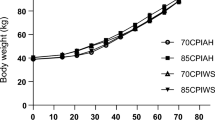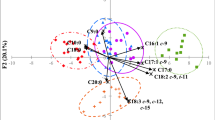Abstract
SINCE 1947, reports have reached us of excessive salivation in ruminants after consuming certain forages. Frequently these forages were red clover hay, but other types of forages were involved. The cattle would consume from 1 to 3 feedings of such forage, salivate excessively, and then refuse further feed. The refusal of the cattle to consume ‘slobber forage’ represents an economic loss to the farmer, including a loss of milk production and the necessity of purchasing replacement forage.
This is a preview of subscription content, access via your institution
Access options
Subscribe to this journal
Receive 51 print issues and online access
$199.00 per year
only $3.90 per issue
Buy this article
- Purchase on SpringerLink
- Instant access to full article PDF
Prices may be subject to local taxes which are calculated during checkout
Similar content being viewed by others
References
Byers, J. H., and Broquist, H. P., J. Dairy Sci., 43, 873 (1960).
Byers, J. H., and Broquist, H. P., J. Dairy Sci., 44, 1179 (1961).
Smalley, E. B., Nichols, R. E, Crump, M. H., and Henning, J. N., Phytopath., 52, 753 (1962).
Bregoff, H. M., Roberts, E., and Delwiche, C. C., J. Biol. Chem., 205, 565 (1953).
Stephenson, Charles H., Some Microchemical Tests for Alkaloids, 110 (J. B. Lippincott, Philadelphia and London, 1921).
Author information
Authors and Affiliations
Rights and permissions
About this article
Cite this article
AUST, S., BROQUIST, H. Isolation of a Parasympathomimetic Alkaloid of Fungal Origin. Nature 205, 204 (1965). https://doi.org/10.1038/205204a0
Published:
Issue date:
DOI: https://doi.org/10.1038/205204a0



